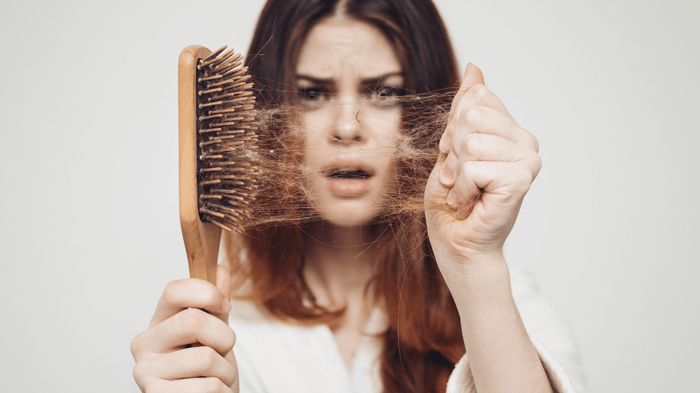
Although hair loss is often treated as a male-specific issue, the truth is that a majority of women will experience hair loss at some point in their lives. 40% of women will have visible thinning by age 40, and then hair loss can be accelerated by hormonal changes during menopause.
Despite the fact that no one talks about it, hair loss is a much bigger issue for women and effects their quality of life.
The most common type of hair loss for women, female pattern hair loss (FPHL), is caused by an overproduction of androgens. Androgens are considered a “male” hormone, but like testosterone, healthy women have low levels of androgens. When your androgen count causes hair loss, is determined by genetics, so there is nothing you can do to prevent the condition. However, there are a variety of treatments available for the symptoms of FPHL.
Other conditions that cause hormonal changes, such as pregnancy, altered birth control, and thyroid problems, also frequently result in hair loss. But unlike FPHL, which is permanent without treatment, hair loss as a result of non-androgen hormonal imbalances will regrow after hormonal balance is restored.
Stress, nutritional deficiencies, certain medications, and even some hairstyles can also cause or exacerbate female hair loss, but like non-androgen hormonal issues, the loss is not permanent.
Androgen-related thinning can now be treated, however, with over-the-counter remedies like minoxidil (brand name Rogaine).
If you have noticed your hair thinning, it’s important to visit a doctor to discuss your options. Although it is likely that your hair loss is androgenic and can be treated at home, hair loss can be a sign of nutritional deficiency, medication interactions, or thyroid problems, and should be evaluated by a professional.
Minoxidil: How It Works
Minoxidil (brand name Rogaine) has long been the biggest name in hair regrowth. Now that the patent has expired, generic versions of minoxidil are widely affordable. The product comes in a twice-daily 2% solution or a once-daily 5% solution, the latter of which was FDA-approved for use by women in 2014. Both concentrations are equally effective at regrowing hair lost to FPHL.
The exact mechanism by which minoxidil stimulates hair growth is still being researched, but we do know that it affects the life cycle of individual hair follicles.
The average hair on your head grows for six years--the anagen phase--and then stops. The hair then moves through the telogen, or resting phase, where it is still attached to your head but not growing, and then is eventually shed when a new hair begins growing underneath it. Usually, about 85% of your hair is growing and 15% is resting at any given time.
On a follicular level, FPHL happens because the follicle gets smaller and spends more time in the resting phase. This results in fewer, thinner hairs.
Minoxidil seems to reverse that follicular-level deterioration by shortening the resting phase and beefing up the follicle’s size.

Risks and Alternatives
Minoxidil has earned its place in the hair loss hall of fame, but are there better ways?
There are limits to minoxidil’s regrowing power. New hair will probably be thinner and shorter than it was before it was lost, and if you discontinue use of minoxidil for any reason all its positive effects will stop with it. Some patients have also reported diminishing effects over time.
In other words: minoxidil will treat your hair loss symptoms, but it is not a cure.
Negative side effects can also be somewhat common. These include an itchy or flaky scalp (caused by other ingredients, not by minoxidil itself) and unwanted hair growth on the cheeks or jawline.
Although it’s an effective treatment for the majority of women with FPHL, these limitations, negative effects, and large time requirements for treatment have spurred on the search for easier, longer-lasting, faster-acting solutions.
Luckily there are many new effective hair treatment options including herbal remedies, light-based therapies, and permanent restoration procedures available to women. A hair loss specialist can help you find the right treatment for your hair goals.





